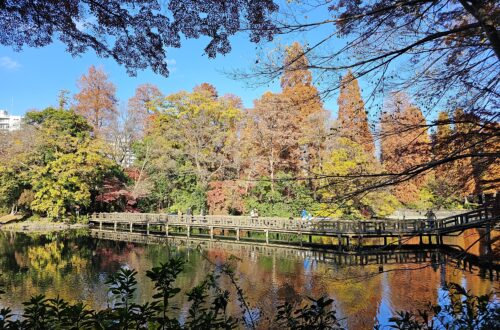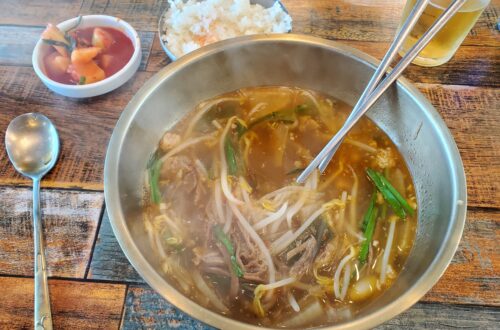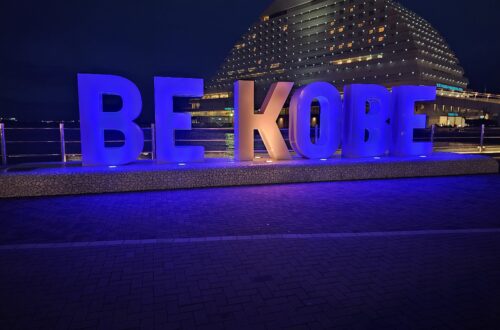-
Thinking Of Going To Japan? Here’s Some Helpful Japan Trip Tips For First Timers!
Going to a new country for the first time can always be a little daunting. Figuring out what you need to take, where to stay, how to get around, what sites you want to visit, it can be a lot! I’ve been to Japan twice now, by no means am I a Japan expert, there’s always something new to learn while traveling through this amazing country. But I have picked up some random Japan trip tips that I feel may be of use for travelers that have never been there.
Choose Where In Tokyo You Want To Stay
This is assuming you’re planning on flying into Tokyo.
First, let’s figure out where exactly in Tokyo you want to stay. Tokyo is an absolutely massive city. It’s comprised of 23 special wards, 26 cities, five towns, and eight villages. Every special ward has several districts within it as well. There’s a lot of options of where to stay due to this. Like A LOT of options.
The most popular places in Tokyo are Shibuya, Shinjuku, Ginza, Roppongi. Unsurprisingly, these will also be the most expensive.
I think what’s most important is how close a subway station is to where you intend to stay. Tokyo’s infrastructure is massive and can get you anywhere in the city, no exaggeration.
So long as you’re within walking distance to ANY station and you know how to use Google Maps then what ward / district you stay in doesn’t much matter to be honest.
How long you’re staying in Tokyo, what your budget looks like, and what you want to see may ultimately influence exactly where you stay.
If you’re only in Tokyo for a couple days then you may want to stay in one of those higher profile areas if those are of interest to you, in order to maximize your time, but I don’t think it’s super necessary.
I’ve stayed in Shinagawa (first trip, has a major train station) and Taito City (second trip, cheap) and both worked out well.
When I stayed in Taito City it took 40 mins to get to Shibuya Station and 30 mins to get to Shinjuku station via subway. I was in Tokyo for five days so that amount of travel time didn’t impact my decision on staying in Taito City. Also, on a side note it took about 15 mins to walk to Asakusa and Akihabara was a 20 min subway ride.
Choosing Which Airport To Fly Into
Tokyo has two major international airports: Haneda and Narita. It’s a little strange that one city has two international airports, but Tokyo is no ordinary major city.
The main difference between the two airports is Haneda is in Tokyo while Narita is located in Narita which is in the Chiba Prefecture, about 37 miles outside of Tokyo. Haneda provides fast access to central Tokyo, and in my opinion is a very convenient experience overall.
There’s many ways to get into the city from the airport via bus, subway, taxi. The subway will likely be the best option for most people. It’s cheaper than a taxi and faster than the bus.
Before booking that flight to Haneda, you can always check to see what the distance is from your hotel to Haneda or Narita. If you’re staying more on the outskirts of Tokyo than the airport may not make much of a difference.
For the sake of providing an example, here’s the difference from Haneda and Narita to Shinjuku Station.
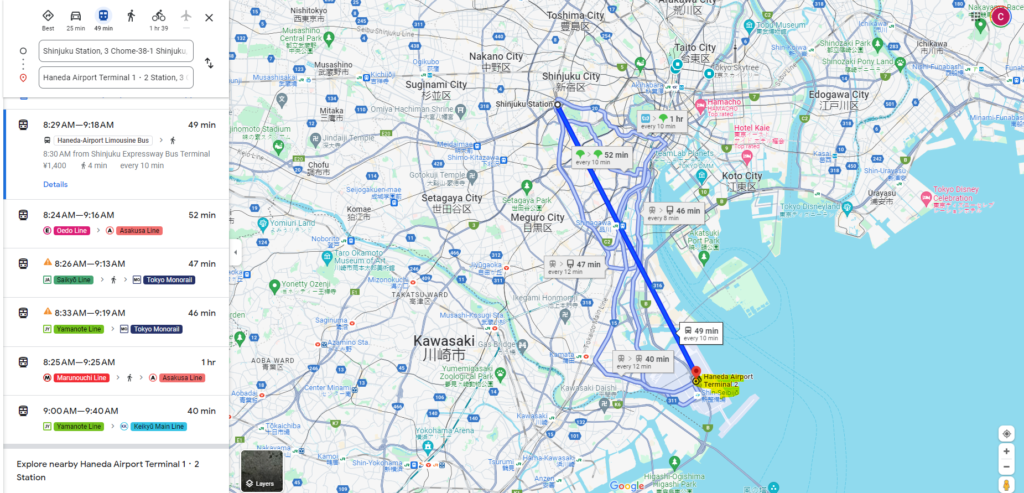
Depending on what lines lines you decide to take, the trip can be as short as 40 mins from Haneda to Shinjuku Station.
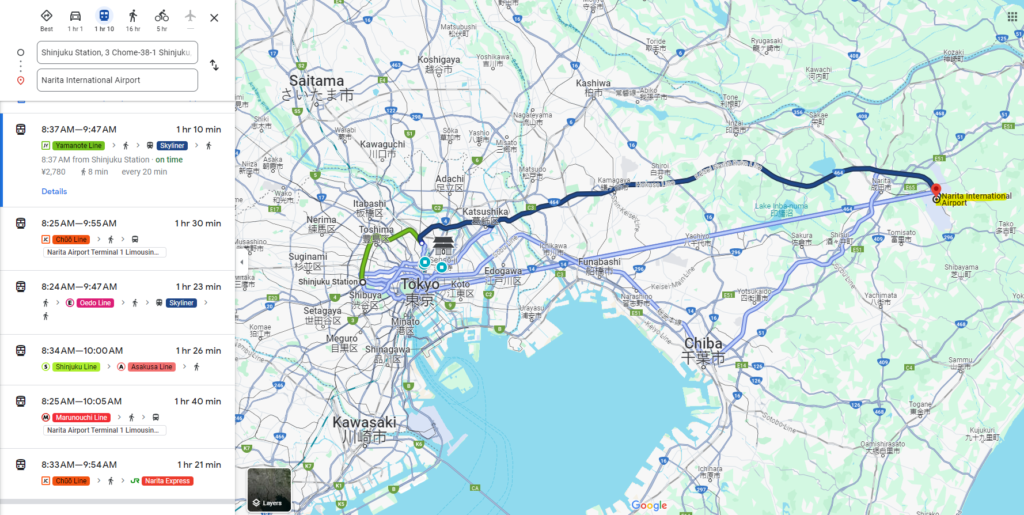
From Narita, the fastest route will take over an hour to Shinjuku Station.
If the flight to Narita is a lot cheaper than Haneda than it makes sense to fly into Narita. Otherwise Haneda will be much faster generally.
Preparing For The Trip
Alright, you know where you’re staying and booked the flight, great! What are some things to pick up prior to the trip?
Get a portable phone charger/ power bank. You will be using your phone a lot. Even more than at home since you’ll be running Google Maps pretty extensively (if traveling on your own, with no tour group) and taking pics and recording videos. A portable phone charger is key so you don’t have to stress when you’re phone hits 15% and you’re far away from your hotel (we’ve all been there!).
Get an esim. If you have a newish phone you should be able to purchase an esim and you absolutely should. It will far and away be the cheaper option.
Renting a pocket wifi will run about $5.50 (USD) per day so if you’re in Japan for two weeks it will run you around $77 USD. A physical sim card will cost around $40-50 for two weeks.
I used Airailo on my last trip to Japan and got 20 GB of data for $26 USD. I was in Japan for 22 days and left with a little less than a GB of data to use. For two weeks in Japan you’d likely need about 10 GB of data. 10 GB will cost about $18. Shop around for esims. They’re cheap and easy to install. Just be sure to install prior to landing so you can just turn on the esim once you land.
An esim is definitely a much cheaper route to go when traveling in general.
Don’t worry about exchanging money prior to your visit. If flying into Haneda, they have ATM’s located throughout the airport in convenient locations. You’ll get a better exchange rate by pulling cash here as well. It’s been a few years since I flew into Narita but imagine this is the same case there as well.
No power converter is necessary (if coming from the US). Japan’s voltage is 100V. Check out the chargers you intend to take. They should have a voltage between 100-240V, those will work fine in Japan. If anything you may need a prong adapter if using a 3 prong input. I believe Japan mainly has 2 prong
inputs.
While In Japan
There’s no trash cans in Japan. Well maybe not ANY trash cans but you won’t be seeing them frequently, if it all. If you get food to go and eat in the vicinity of the restaurant you won’t see any trash cans near by. What you’ll need to do is hand the trash back to the restaurant you bought the food from to dispose of. If you’re eating on the go it’s best to store the trash in your backpack and throw it away when you get back to the hotel.
Don’t worry about the huge amounts of change you accumulate. Without a doubt you’ll be carrying around a large amount of change within days of being in Tokyo. No need to worry about that, it’s easy to get rid of. There’s vending machines literally EVERYWHERE in Tokyo. Get some beverages and put that change to good use.
My favorite was going to 7-11. You can literally dump change into a coin collector to pay for whatever you purchase. You’ll see your total amount and as you put change in that amount decreases. It’s a great way to get rid of a variety of different change amounts.
Spend money leftover money on your IC Card (rechargeable prepaid travel cards used for public transportation) . If at the end of your trip you have an ample amount left on your IC Card, there’s other ways you can spend that amount outside of public transportation. Vending machines and convenience stores (again) come in handy. They both accept IC cards as payment options.
You’ll Figure It Out
There’s a million other tips that will be helpful but the above are just little things that came to mind when first wanting to write a blog post about helpful tidbits for first time travelers to Japan. They all seemed to be scattered around but not condensed into one article or blog post. Hope it helps!
